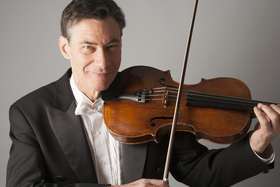|
Back
Surrounded by Beethoven Houston
Jones Hall
03/04/2016 - & March 5, 6, 2016
Ludwig van Beethoven: Symphonies No. 2 in D Major, Op. 36, & No. 8 in F Major, Op. 93
Gabriela Lena Frank: La Llorona: Tone Poem for Viola and Orchestra
Wayne Brooks (viola)
Houston Symphony, Andrés Orozco-Estrada (conductor) 
W. Brooks (© Eric Arbiter)
Andrés Orozco-Estrada kicked off three weeks of concerts focusing on Beethoven symphonies with vigorous, straightforward readings of the Second and Eighth, two of the composer’s sunnier essays. Two further concerts will feature the Third and Ninth, and each of the three concerts intermixes those iconic symphonic statements with 20th- and 21st-century works. For the first round, Houston Symphony composer-in-residence Gabriela Lena Frank was on hand to introduce a revival of her 2007 La Llorona, a programmatic work for viola and orchestra composed for the HSO and its stellar principal violist, Wayne Brooks.
Both Beethoven symphonies received vigorous, straightforward performances that always satisfied and occasionally thrilled. In the first movement of the Second, the chain of suspensions preceding the coda was the clear goal of the interpretation, with previous climaxes slightly downplayed to allow that passage pride of place in the proceedings. The second movement Larghetto’s development section lacked the last ounce of tension, but this was easily offset by outstanding solos and duos from woodwinds and horns. Both the scherzo and finale saw Orozco-Estrada and his band relishing Beethoven’s musical mischievousness.
Energy was likewise the focus of the Eighth. In a video presentation, Orozco-Estrada pointed in particular to the metronomic inspiration for the second movement and Beethoven’s gutsily exaggerated tempo indication for the finale, and especially the closing timpani gestures. The woodwinds’ tick-tocking started off a bit shaky but gained firm footing, while the whip-crack tempo of the fourth movement brought crisp, precise articulation from the strings and timpani. A highlight of the performance was the Trio in the third movement, featuring playing of utmost finesse from the two horns and clarinet.
Between the two symphonies came Frank’s concertante fantasy. The work itself has a beautiful backstory of frustration, transformation, and surrender, all rooted in South American folklore. While some sonorities, especially from an enlarged percussion battery, allowed the listener to easily appreciate the work’s programmatic origins, other moments were oddly referential to standards of European concert music. The opening, in particular, brought Ravel’s Left Hand Concerto immediately to mind. Frank replaces Ravel’s contrabassoon with bass clarinet, but both woodwinds emerge from the depths of murmuring double basses, lead to descending melodic statements in the horns, and dramatically blossom to a half cadence, ushering in the soloist. Likewise, the two moderately fast sections (both marked “Flight”) of Frank’s otherwise slow and atmospheric work strongly allude to the chase music from Bartók’s Miraculous Mandarin. The heart of the work (“Canto de la Luna”) was gorgeously effective, but the ending lacked magic. The solo viola, a reluctant spirit surrendering to its entrapment in the orchestra’s netherworld, simply restates the bass clarinet’s opening melody. The framing device makes sense to the story, but leaves the listener wishing for a more mystical sonic metamorphosis. Brooks had no problems negotiating the demanding solo part, and Orozco-Estrada and the orchestra shadowed every move, playing with impressive delicacy in the work's hazy outer sections.
Marcus Karl Maroney
|